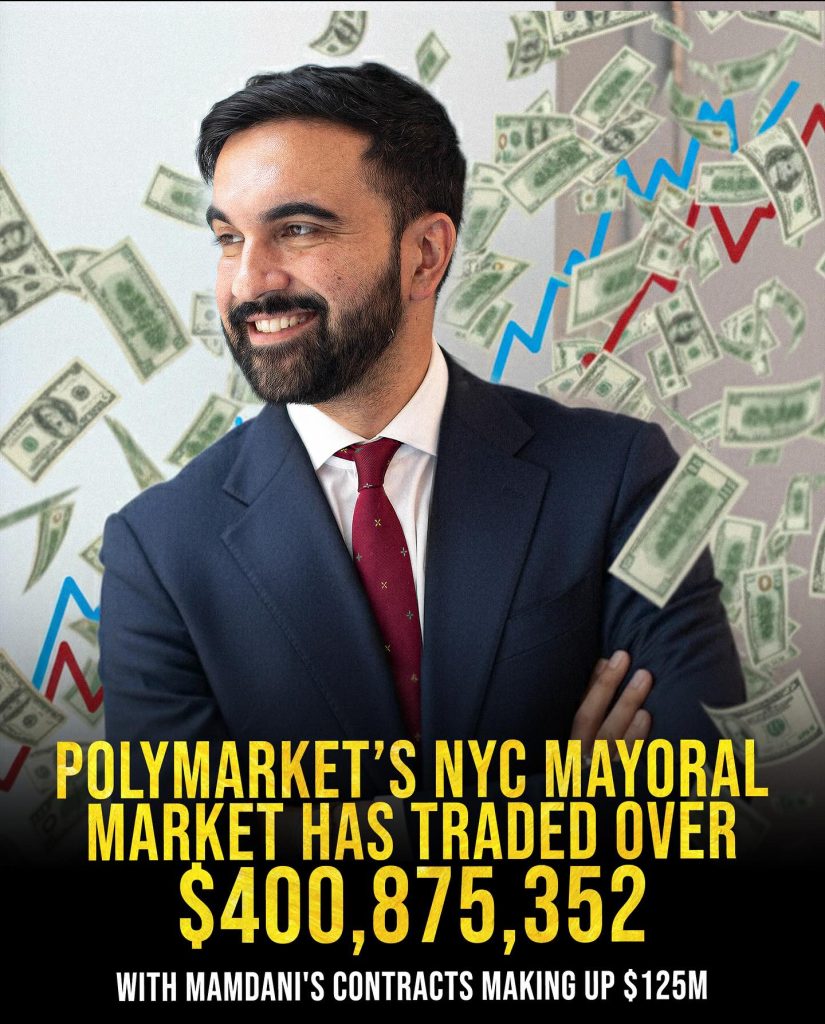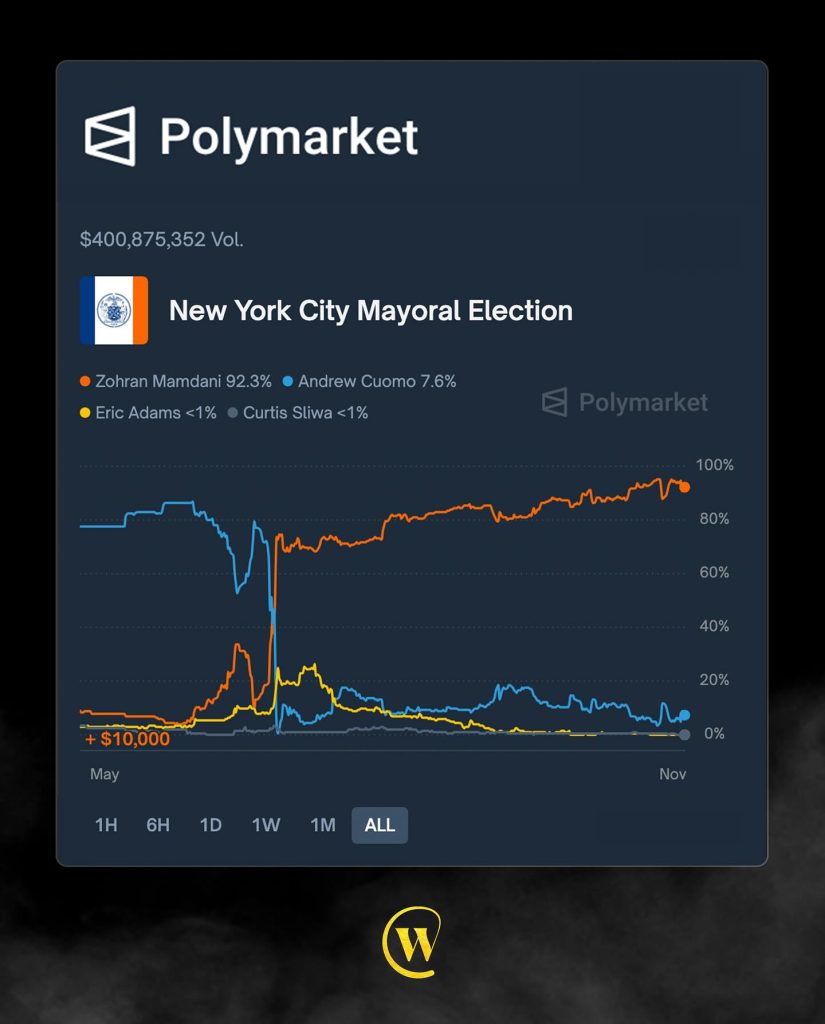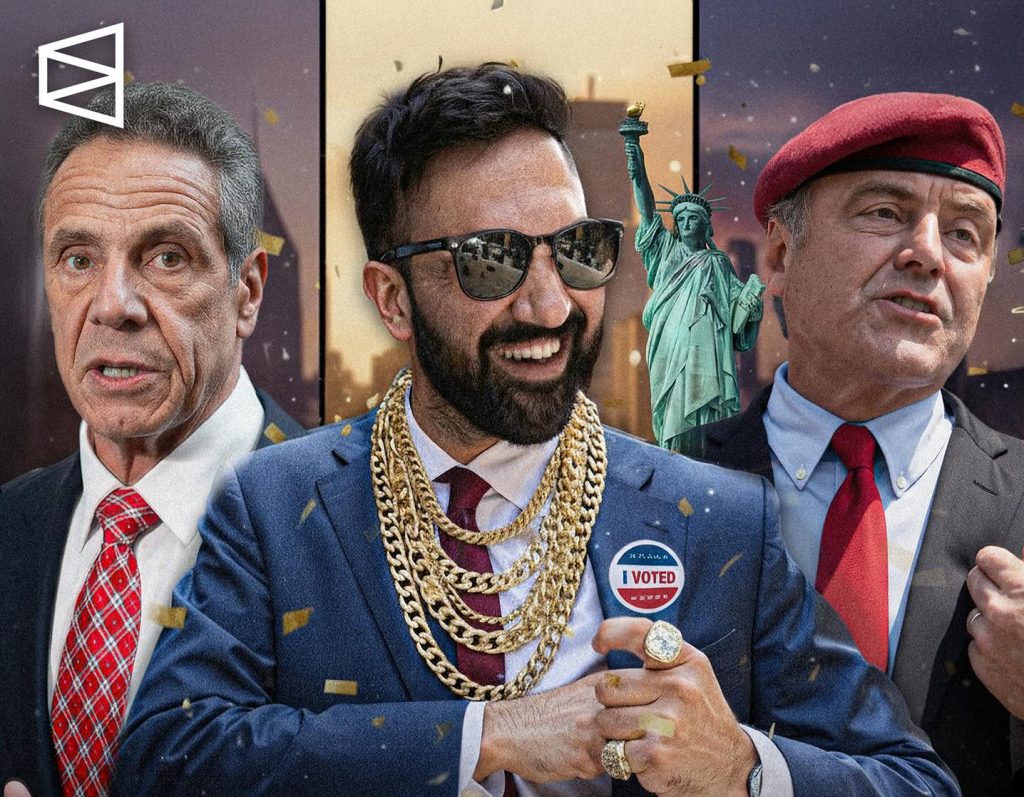Zohrán Mamdani Heads Into the 2025 New York City Mayoral Election with a 92% Win Probability on Polymarket — As Over $400 Million in Bets Flood the Race
As New York City braces for one of its most closely watched elections in years, a new kind of spotlight has fallen on an unexpected stage — the prediction markets. On Polymarket, the blockchain-based prediction exchange that allows traders to bet real money on political outcomes, the race for the 2025 New York City mayoral seat has exploded into a financial frenzy. With more than $400,875,352 traded, the market has become a digital barometer of public sentiment, political momentum, and global curiosity. At the center of it all stands Zohran Mamdani — the progressive state assemblyman from Queens — whose odds have surged to a staggering 92.3% chance of victory, dwarfing his rivals and reshaping expectations for the city’s political future.

For weeks, analysts, journalists, and traders alike have watched as Mamdani’s orange line on Polymarket’s charts climbed steadily upward, reflecting confidence not only from his supporters but from speculators around the world. The market has priced former Governor Andrew Cuomo, running as an independent under the “Fight & Deliver” ballot line, at just 7.6%, while Republican candidate Curtis Sliwa — once a familiar name in city politics — trails at less than 1%. Current mayor Eric Adams, whose tenure has been marred by controversies and falling approval ratings, is now a near-nonfactor in the race, with traders giving him virtually no shot at re-election.
The surge in Mamdani’s prediction odds did not happen overnight. It was the product of a long, carefully orchestrated campaign that blended grassroots energy with modern political strategy. Known for his sharp economic messaging and his work advocating for tenants’ rights and public transit, Mamdani has positioned himself as a voice of the working class — a message that resonates powerfully in a city struggling with rent hikes, inequality, and an eroding sense of community. His rise mirrors a broader shift within Democratic strongholds across the country, where younger, more progressive candidates are increasingly challenging establishment figures.
Polymarket’s data offers a unique glimpse into how that shift translates into real-time sentiment. Each movement on the chart reflects thousands of individual trades — every spike or dip capturing moments of momentum, missteps, or breaking news. Early in the race, Andrew Cuomo appeared to have the upper hand. His name recognition and years of political experience gave him a head start, and for a brief moment, his line on the chart surged past Mamdani’s. But that advantage evaporated as new polls rolled in and as grassroots organizations threw their weight behind the Queens assemblyman. By mid-summer, Mamdani’s confidence curve had overtaken Cuomo’s, and from that point forward, the trajectory never reversed.
The $400 million in total trading volume reflects more than just curiosity — it’s a measure of how seriously political prediction markets have begun to influence public discourse. Unlike traditional polls, which rely on survey sampling and statistical modeling, platforms like Polymarket draw their insights from monetary risk. Every trader putting down dollars on Mamdani’s victory is, in essence, wagering that his campaign strategy, voter appeal, and political climate will hold steady through Election Day. For political observers, these aggregated bets offer a fascinating snapshot of crowd psychology — one that, historically, has proven surprisingly accurate.

Still, critics argue that prediction markets should not be mistaken for polls. Unlike regulated financial instruments, Polymarket operates in the gray zone of decentralized finance, where global users can participate without the same oversight as Wall Street exchanges. That doesn’t make the data less interesting — but it does mean it reflects more than just voter sentiment. It’s a fusion of perception, speculation, and even entertainment. In this case, though, the consensus has been overwhelming: traders believe Zohran Mamdani will be the next mayor of New York City.
Behind Mamdani’s meteoric rise lies a campaign defined by authenticity and focus. The 33-year-old son of Ugandan-Indian immigrants has long stood out for his eloquence and policy-driven approach. Elected to the New York State Assembly in 2020, Mamdani quickly made a name for himself as a fierce advocate for housing reform, public transportation investment, and social equity. His critics have called him “too idealistic,” but supporters see that same quality as his greatest strength — a symbol of conviction in a political world too often dominated by caution and compromise.
When Mamdani won the Democratic primary earlier this year, it was clear that the city’s political landscape was shifting. Cuomo’s attempt to reclaim relevance through an independent bid was met with skepticism, not enthusiasm. Many Democrats saw it as a return to the old guard — a reminder of political eras marked by scandal and consolidation of power. Meanwhile, Curtis Sliwa’s campaign struggled to find traction beyond his loyal base. What was once a three-way race began to look increasingly like a one-man sprint.
As Election Day approached, the atmosphere in New York felt charged — not just with politics, but with anticipation. Polymarket traders mirrored that energy, driving the total trading volume to unprecedented levels. Reports show that Mamdani’s contracts alone accounted for roughly $125 million of that total, a remarkable indicator of confidence. The platform’s interface, showing his orange trendline soaring above the rest, became a visual metaphor for the state of the race.
For Mamdani, the moment carries more weight than just political victory. If elected, he would become the first Muslim mayor in New York City’s history, a milestone that underscores both the diversity and the transformation of the city’s political identity. It would also place him among a growing list of progressive leaders redefining urban governance across America — from Boston’s Michelle Wu to Chicago’s Brandon Johnson. Each of these figures represents a new generation of leadership that blends social justice priorities with pragmatic governance.

Cuomo’s campaign, meanwhile, has tried to frame itself as a comeback story — a redemption arc for a former governor who insists his experience is precisely what New York needs. But his messaging has struggled to connect. The independent line “Fight & Deliver” aimed to invoke a populist spirit, yet many voters see his bid as more about personal vindication than public service. As for Curtis Sliwa, his familiar red beret and tough-on-crime rhetoric have not been enough to recapture the momentum that briefly carried him into prominence during the last election cycle.
Observers note that while Mamdani’s odds may appear overwhelming, nothing in politics is ever guaranteed. Markets, after all, can shift in an instant. A single late-breaking scandal, a poor debate performance, or an unexpected event could still ripple through the charts. Yet, for now, the trajectory is clear. Mamdani’s 92% forecast represents not just trader confidence but a sense of inevitability — a feeling that the race has already been decided in the court of public sentiment, even before the final votes are counted.
The Polymarket phenomenon itself has become part of the story. Once dismissed as a niche experiment in crypto speculation, it has grown into a data powerhouse that captures the intersection of technology, politics, and finance. In a world increasingly shaped by decentralized platforms and public prediction, Polymarket has emerged as a real-time political mood ring — tracking, reacting, and even influencing how narratives unfold. That its most active market now revolves around New York City, the media capital of the world, feels fitting. Every uptick in Mamdani’s odds becomes another headline, another viral chart, another signal of how deeply intertwined digital markets and democratic processes have become.
By late October, the Polymarket chart had flattened — Mamdani’s dominance so complete that even major news cycles failed to dent his momentum. His campaign events drew record crowds across the boroughs, while social media buzzed with clips of his impassioned speeches about housing, climate, and justice. Cuomo’s team released a series of last-minute ads attempting to cast doubt on Mamdani’s readiness for the job, but the needle barely moved. The markets barely flinched.
As polls opened on November 4, the city stood at a crossroads. For many voters, Mamdani represents hope — a chance to reimagine what leadership in New York can look like. For others, he’s a risk, a leap into the unknown. But whether his critics like it or not, the data doesn’t lie: the overwhelming majority of traders, pollsters, and observers believe Zohran Mamdani is about to make history.
If he does, his victory will mark not just the end of a campaign, but the beginning of a new chapter for New York — one where political imagination and public trust intersect in ways rarely seen before. And for Polymarket, it will stand as another proof of concept: that in an age where information moves faster than ever, the crowd often knows the outcome long before the ballots are counted.
In the end, whether through the roar of campaign rallies or the quiet flicker of digital bets placed from around the world, the story of the 2025 New York City mayoral election may go down as one of the clearest examples yet of how technology, finance, and democracy have fused into a single, real-time narrative — one where millions of voices, and billions of dollars, all converge on the same prediction.


